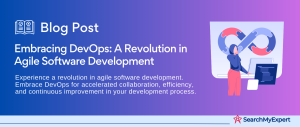Containerization and DevOps: Transforming Software Development
In the fast-paced world of modern software development, staying ahead of the curve is crucial. Two trends that have gained significant traction in recent years are DevOps and containerization. In this article, we’ll dive into these transformative practices, exploring what they are and why they matter.
What is DevOps?
DevOps is not just a buzzword; it’s a paradigm shift in the way software development and IT operations collaborate. At its core, DevOps emphasizes breaking down the silos between these two traditionally separate teams and fostering a culture of collaboration and shared responsibility.
Core Principles of DevOps:
- Collaboration:
DevOps encourages developers and operations teams to work together seamlessly, eliminating the traditional wall that often exists between them. - Automation:
Automation is at the heart of DevOps. It involves streamlining repetitive tasks, reducing manual errors, and accelerating the software delivery process.
Containerization
Containerization is a technology that has revolutionized the way applications are developed, deployed, and managed. It involves packaging an application and its dependencies into a single, lightweight, and portable unit known as a container.
Key Features of Containers:
- Isolation: Containers provide a secure and isolated environment for applications to run, ensuring that they don’t interfere with each other.
- Portability:
Containers can run consistently across different environments, from a developer’s laptop to production servers, without any compatibility issues. - Efficiency: Containers are resource-efficient and boot up quickly, making them an ideal choice for microservices architectures.
The Rise of DevOps and Containerization
Both DevOps and containerization have gained immense popularity in the software development world due to the numerous benefits they offer.
DevOps streamlines the software development lifecycle, reducing bottlenecks, and enabling teams to deliver software faster and with higher quality. It encourages a culture of continuous integration and continuous delivery (CI/CD), where code changes are automatically built, tested, and deployed.
Containerization, on the other hand, addresses the challenges of consistency and portability in application deployment. Containers provide a standardized environment, making it easier to develop and deploy applications across various platforms.
Understanding Containers: Think of Them as Digital Lunchboxes
In the world of software, containers are like digital lunchboxes. Let’s break down what they are and why they’re so handy using a simple analogy.
Think of Containers Like Digital Lunchboxes
Imagine you need to transport your favorite snacks to school. In the past, you might have used different kinds of lunchboxes, each with its quirks. Some were too big, some too small, and some needed special care.
Now, picture a magical lunchbox that’s always the same size and shape, no matter what you put inside. It’s like a lunchbox that can hold anything, from sandwiches to fruits. Plus, it’s super easy to carry and fits perfectly into your backpack. That magical lunchbox is what a container is in the world of software.
What’s Inside the Digital Lunchbox (Container)?
- Your Snacks (Code): Inside the lunchbox (container), you put your favorite snacks, which are like the instructions for your software.
- The Right Environment: The lunchbox also has a built-in environment to make sure your snacks taste the same no matter where you open it. This is like making sure your software runs the same way on different computers.
- Ingredients (Dependencies): If your snacks need any special ingredients, like peanut butter for your sandwich, the lunchbox (container) has them ready inside.
- Special Instructions (Configuration): There’s a note inside the lunchbox that tells you how to enjoy your snacks just the way you like them. In software, this is like setting how your program should behave.
Containers vs. Traditional Lunchboxes (Virtual Machines)
Now, let’s compare our digital lunchbox (container) to something you might know, a traditional lunchbox (virtual machine).
Using Resources:
- Digital Lunchbox (Container):
It’s tiny and doesn’t take up much space in your backpack. You can even share it with your friends without any problems. - Traditional Lunchbox (Virtual Machine): It’s bigger and heavier because it comes with a full set of plates, forks, and knives. You’d need a separate backpack for this one.
Keeping Snacks Separate:
- Digital Lunchbox (Container): It’s like having a few snacks in separate compartments within the same lunchbox. They’re close, but they won’t mess up each other’s flavors.
- Traditional Lunchbox (Virtual Machine): This lunchbox is like having multiple separate lunchboxes, each with its snacks and plates. They don’t mix, but they take up a lot of space.
Opening Time:
- Digital Lunchbox (Container):
It opens almost instantly, so you can start munching right away. - Traditional Lunchbox (Virtual Machine):
This one takes a bit of time to open because you need to set up all the plates and utensils.
Supercharging DevOps with Containers: The Benefits You Can’t Ignore
Containerization isn’t just a fancy term; it’s a game-changer for DevOps teams. In this step, we’ll uncover how containerization turbocharges the DevOps process by speeding up software delivery, enhancing portability, and making resource management a breeze.
The Need for Speed: Faster Software Delivery
In the world of DevOps, speed is everything. Containerization plays a pivotal role in accelerating the software delivery pipeline, thanks to several key advantages:
- Streamlined Deployments:
Containers make deploying software a breeze. You can package your application, along with all its dependencies, into a single container image. This image can be easily transported and executed across different environments, from development to production, without compatibility hiccups. With traditional methods, ensuring consistency between environments often resulted in delays and errors. - Rollbacks Made Easy: Mistakes happen, and when they do, rolling back to a previous version of your application should be painless. Containers enable version control and easy rollbacks, as you can revert to a previous container image with a single command. This reduces downtime and minimizes the impact of errors, ensuring a smoother DevOps journey.
Portability and Scalability: Taking Your App Anywhere
Containers are the digital globetrotters of the software world. They offer unmatched portability and scalability, which are invaluable for DevOps teams:
- Portability:
Containers encapsulate everything your application needs to run consistently. This means you can develop your app on your laptop and confidently move it to a production server, a cloud platform, or even to a colleague’s machine without worrying about compatibility issues. This portability streamlines collaboration and testing, a must-have for DevOps success. - Scalability:
DevOps often involves managing applications that need to scale up or down based on demand. Containers excel in this regard. You can easily duplicate containers to handle increased load, and when the demand subsides, you can scale back down. This elasticity is a major win for resource management and cost-effectiveness.
Resource Efficiency and Cost Savings
Every organization appreciates cost savings. Containers are resource-efficient and provide better isolation compared to traditional methods:
- Resource Efficiency: Containers share the host operating system’s kernel, which means they consume fewer resources compared to running multiple virtual machines. This efficiency translates to reduced infrastructure costs, a welcome sight on any DevOps budget.
- Isolation:
While containers share the kernel, they are still isolated from each other. This ensures that one container’s activities don’t interfere with another, providing a balance between resource utilization and application isolation. In contrast, traditional virtual machines are more resource-heavy due to their separate operating systems.
Leading the Containerization Revolution: Docker and Kubernetes
In the world of containerization, two stars shine the brightest: Docker and Kubernetes. These technologies have transformed the DevOps landscape, enabling teams to manage containers efficiently. Let’s dive into what makes them stand out and explore other essential containerization tools.
Docker: The Containerization Pioneer
Docker is like the trailblazer in the containerization world. It provides a platform to create, deploy, and manage containers effortlessly.
Key Advantages for DevOps:
- Ease of Use:
Docker makes it simple to create and package applications into containers. DevOps teams love it for its user-friendly interface and quick learning curve. - Portability:
Docker containers are highly portable, making it easy to move applications between environments. This portability simplifies testing, collaboration, and deployment. - Version Control: Docker allows you to version your container images, making it straightforward to track changes and roll back to previous versions if needed.
Kubernetes: The Container Orchestration Master
Kubernetes, often abbreviated as K8s, takes containerization to the next level by providing container orchestration. It’s like the conductor of an orchestra, ensuring all containers play in harmony.
Key Advantages for DevOps:
- Orchestration:
Kubernetes automates container deployment, scaling, and management. It ensures that your application runs smoothly, even in complex setups. - Scaling: DevOps teams love Kubernetes for its ability to automatically scale applications based on demand. It can handle the orchestration of hundreds or even thousands of containers effortlessly.
- Self-Healing: If a container fails, Kubernetes detects it and replaces it with a healthy one, reducing downtime and maintaining high availability.
Other Essential Containerization Tools
While Docker and Kubernetes are the stars of the show, the containerization ecosystem offers various supporting tools and technologies:
- Container Registries: Container registries like Docker Hub and Google Container Registry are like libraries for your container images. They store and distribute your containers, ensuring that everyone on your team has access to the latest versions.
- Container Orchestration Platforms: Besides Kubernetes, there are other container orchestration platforms like Amazon ECS, Apache Mesos, and Docker Swarm. These platforms help manage and scale containers in different ways, catering to diverse DevOps needs.
- Container Networking Solutions: Tools like Calico and Flannel provide networking solutions for containers. They ensure that containers can communicate with each other securely and efficiently.
- Container Security Tools:
Security is paramount in DevOps. Tools like Clair and Aqua help scan container images for vulnerabilities and enforce security policies.
Containerization in DevOps Pipelines: A Seamless Integration
Integrating containerization into the DevOps Continuous Integration/Continuous Delivery (CI/CD) pipeline is like adding a turbocharger to your software development process. Let’s explore how containerization fits into each stage, from development and testing to production deployment.
Continuous Integration (CI)
In the CI phase, developers frequently merge their code changes into a shared repository. Containers play a vital role by providing a consistent environment for building and testing applications.
Building and Testing in Containers:
- Developers create container images that include the application code, dependencies, and testing tools.
- These images ensure that the application behaves the same way in every environment, eliminating “it works on my machine” issues.
- Automated tests are run inside containers, ensuring that code changes meet quality standards.
Continuous Delivery/Continuous Deployment (CD)
In the CD phase, containers continue to shine as they facilitate the deployment of applications to various environments, including production.
Consistent Deployments:
- The same container image that was tested in the CI phase is deployed to various environments, ensuring consistency.
- Containers simplify the process of deploying applications to different platforms, whether it’s on-premises servers, cloud, or Kubernetes clusters.
- Rollbacks are painless, as you can easily switch to a previous container image if issues arise in production.
Benefits of Containerization in DevOps Pipelines
- Isolation:
Containers provide isolation, ensuring that applications and their dependencies don’t interfere with each other. This is crucial for maintaining a stable CI/CD pipeline. - Efficiency: Containers are lightweight and quick to start, allowing for rapid parallel testing and deployment, speeding up the CI/CD process.
- Consistency: Containers guarantee that what works in one environment will work the same way in another, from development to production.
- Version Control: Container images can be versioned, making it easy to track changes and roll back to previous versions when necessary.
Bringing It All Together
Containerization has become an integral part of modern DevOps pipelines, making it possible to develop, test, and deploy applications efficiently and consistently. With containers, you can ensure that your software behaves predictably across various environments, leading to faster and more reliable software delivery.
Challenges and Considerations in Containerization
While containerization offers numerous advantages, it’s not without its challenges and considerations. In this step, we’ll explore some of the key concerns that come with the territory.
Security Concerns
Vulnerabilities in Container Images
Containers may contain security vulnerabilities, especially if not properly managed. Developers must be diligent in keeping container images up to date and regularly scanning them for known vulnerabilities.
- Mitigation:
Employ container image scanning tools and follow best practices for image maintenance to reduce security risks.
Shared Resources
Containers share the same kernel, which can lead to potential security issues if not configured properly. An insecure container can affect others on the same host.
- Mitigation:
Implement strong isolation practices, use security namespaces, and regularly audit container configurations for potential vulnerabilities.
Managing Container Complexity
As applications become more complex, managing multiple containers that interact with each other can be challenging. Orchestrating these containers effectively is crucial for a smooth deployment.
- Mitigation:
Utilize container orchestration platforms like Kubernetes to automate container management and ensure scalability and reliability.
Learning Curve
Containerization technologies like Docker and Kubernetes can have a steep learning curve for teams unfamiliar with them. Adapting to these new tools and practices may require time and effort.
- Mitigation:
Invest in training and documentation to accelerate the learning process. Start with small, manageable projects to gain experience.
Containerization Best Practices
To address these challenges, here are some containerization best practices:
- Regular Updates: Keep container images and their dependencies up to date to mitigate security risks.
- Security Scanning:
Implement automated image scanning to identify and remediate vulnerabilities. - Container Orchestration: Utilize container orchestration platforms like Kubernetes for efficient container management.
- Monitoring and Logging: Implement robust monitoring and logging solutions to identify and troubleshoot issues quickly.
- Documentation:
Maintain clear and comprehensive documentation for containerized applications and processes.
Containerization and DevOps – A Powerful Duo
In this journey through containerization and DevOps, we’ve uncovered a dynamic duo that’s transforming the landscape of software development. Let’s wrap it up by summarizing the key benefits, looking at the future, and providing resources for further exploration.
The Power of Containerization and DevOps
- Efficiency:
Containerization streamlines the software development lifecycle, enabling rapid development, testing, and deployment. - Consistency:
Containers ensure that applications behave predictably across different environments, reducing deployment issues. - Scalability:
DevOps practices, combined with containers, allow for effortless scaling to meet varying demands. - Resource Efficiency:
Containers optimize resource utilization, leading to cost savings. - Security:
When managed correctly, containers enhance security through isolation and version control.
The Future of Containerization
Containerization is poised to continue its ascent in the software development landscape. As technology evolves, containers will likely become even more efficient and secure. Moreover, container orchestration tools like Kubernetes will play a central role in managing containerized applications at scale.
Resources for Further Learning
- Docker Documentation:
Dive deep into Docker’s official documentation to master containerization. - Kubernetes Documentation: Explore Kubernetes documentation to become proficient in container orchestration.
- DevOps Institute: Stay updated with the latest DevOps practices and certifications.
- Container Security Best Practices: Learn about best practices for securing containers.
- The DevOps Handbook: A must-read book for in-depth insights into DevOps practices.
Conclusion
The fusion of containerization and DevOps is a transformative force in software development. It offers efficiency, scalability, and security while ensuring consistent application behavior across diverse environments. As technology advances, containerization’s impact on the industry will only grow, with Kubernetes and similar tools taking center stage. To delve deeper into this dynamic field, explore Docker and Kubernetes documentation, consider DevOps certifications, and stay informed about container security best practices. Embrace this evolution, as containerization and DevOps continue to shape the future of agile and efficient software development.
Forge a path to continuous improvement with DevOps Service Firms.
Table of Contents
Toggle






